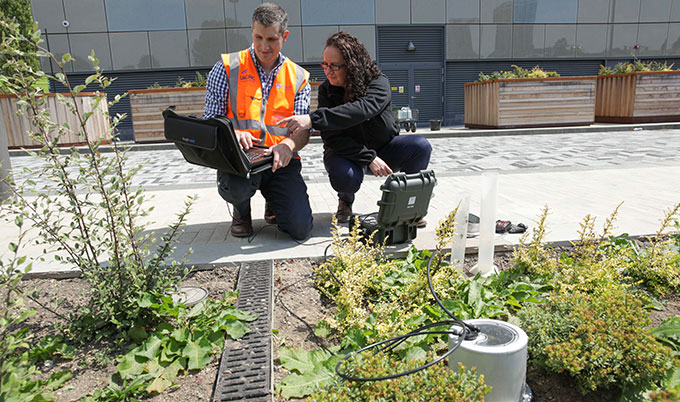SUDS open days
Outdoor ‘living lab’ to explore solutions to city centre flooding
Published on: 6 July 2018
An outdoor lab in the heart of Newcastle city centre is being used to develop and test new approaches to managing the impact of flooding.
Understanding drainage patterns
Features such as different types of planting, swales and green roofs are being used by researchers at Newcastle University to better understand how to reduce the risk of flooding such as that seen on 28 June 2012, the infamous ‘Toon Monsoon’.
The work is part of a number of projects being carried out at the National Green Infrastructure Facility at Newcastle Helix into sustainable drainage systems (SuDS). SuDS can reduce the risk of flooding by slowing, storing and filtering water using vegetation and soils to create drainage patterns more like the natural landscape.
The facility includes hundreds of sensors linked to Newcastle’s Urban Observatory which provide data about the interactions between the SuDS features, other infrastructure, and weather conditions. From this, researchers can simulate floods and other extreme weather events and use the data to create models of how SuDs features can influence the way that water flows through the city.

Resilient cities
Visitors will be able to see the range of SuDS measures researchers are exploring and hear first-hand from some of the experts leading the work at Newcastle at a series of events and open days this month, taking place as part of Newcastle University's 'Inspired by' Great Exhibition of the North programme.
Dr Ross Stirling, Lecturer in Geotechnical Infrastructure, Newcastle University, explains: “Sustainable drainage systems can make our cities more resilient against flooding by taking pressure off ‘grey’ infrastructure such as drains and sewers. By linking our research to the city-wide data collected by the Urban Observatory, it gives us a much better picture of how extreme weather affects the networks and services we depend on.
“These events will provide an opportunity to learn about active research into how urban green spaces can provide a solution to flooding as well as delivering other benefits such as improving biodiversity and helping to regulate the temperature in cities.”
Funded by EPSRC, the National Green Infrastructure Facility is part of UKCRIC - a network of 14 universities and partner organisations working together to better understand and address the challenges that face our essential infrastructure.
The National Green Infrastructure Facility Open Day events take place at Holmes Avenue, Urban Sciences Building, Newcastle Helix on the following dates: 11 July, 1.00pm – 4.00pm; 25 July, 1.00pm – 4.00pm; and 28 July, 11.00am – 2.00pm.
For information about other events taking place as part of the University’s Inspired by Great Exhibition of the North programme, visit www.ncl.ac.uk/events/great-exhibition-of-the-north/



